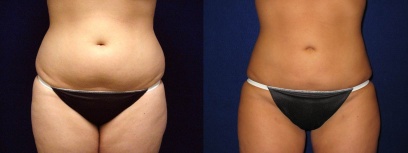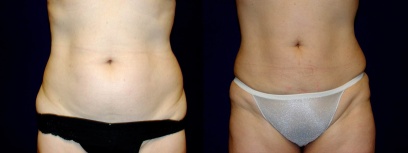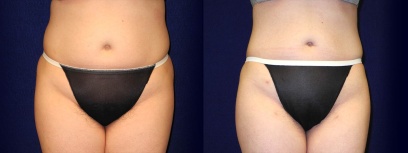LIPOSUCTION
Diet and exercise do not always allow patients to lose weight in their problems areas. Liposuction is effective in removing fat from targeted areas of the body. The abdomen, hips, back, buttocks, thighs, chin and the male chest, are common regions where liposuction is performed. Liposuction is conceptually simple. A healthy patient with areas of excess fat has these areas reduced by vacuuming the fat through small metal tubes called cannulas. This procedure is frequently done on an outpatient basis under general anesthesia in a hospital or accredited surgical facility. Most liposuction begins with the surgeon infiltrating a special “Tumescent” solution into the fatty tissues to be suctioned. This solution is mostly salt water, but also contains adrenaline to reduce blood loss and may contain a local anesthetic to reduce pain. Use of the the tumescent fluid allows for more accurate and thorough fat removal. Patients who undergo tumescent liposuction typically experience less bleeding, swelling, bruising, and pain than patients who undergo traditional liposuction.
Following the injection of this “tumescent” fluid, fat removal begins. In certain cases, the initial phase of liposuction involves ultrasound cannulas, which loosen the fat to be removed. This is followed by standard liposuction, where a vacuum is employed to remove the excess fat. At the end of the procedure, the patient is placed in a compression garment to reduce postoperative swelling. In most cases, the patient is discharged home the same day and returns to work in a few days. When more significant fat removal is performed (greater than 10 pounds), patients are usually observed overnight.
Areas Treated with Liposuction
Liposuction can remove fat from the chin, neck, jowls, cheeks, arms, inner and outer thighs, buttocks, knees, hips, and abdomen. Men with enlarged breasts can also benefit from this procedure for male breast reduction. Ultrasonic assisted liposuction is ideally suited to correct this condition.
Some patients also undergo a tummy tuck, breast augmentation, or breast lift in conjunction with the liposuction procedure.
Ultrasonic-Assisted Liposuction (UAL)
Similar to standard liposuction, ultrasonic liposuction employs use of a hollow cannula to remove fat. The cannula is connected to an ultrasound generator, which causes the cannula to vibrate more than 22,000 times per second. When applied to fat, this vibration causes the fat cells to rupture, allowing the emulsified fat to be removed. This technique is most beneficial in revision liposuction, where standard liposuction has previously been performed, as the ultrasonic probe can help break through scar tissue. The downside of Ultrasonic Liposuction is the ultrasonic probe transmits heat to the tissue. This results in more trauma than normal liposuction and can result in increased pain and prolonged recovery. Therefore, Ultrasonic Liposuction is not the best procedure for every patient.
Tumescent Liposuction
During the tumescent liposuction procedure, a solution is injected into treatment areas before the fat is removed from the body. The injections contain epinephrine, which causes blood vessels to constrict and the target fatty tissue to become more swollen and firm, and thus easier to remove.
Use of the anesthetic solution and the tumescence of fat allows for more accurate and thorough fat removal. Because fat is easier to remove, our Dallas liposuction patients do not need to be put under during surgery, the side effects and recovery time associated with the tumescent method are significantly minimized. Patients who undergo tumescent liposuction typically experience less bleeding, swelling, bruising, and pain than patients who undergo traditional liposuction.
Featured Cases

Liposuction
This 24 year old was 5'6" and weighed 140 pounds and felt she was too "thick" around the middle. She therefore underwent tumescent liposuction.
+ See Full Case
Liposuction
This 49-year-old female felt her midsection was poorly defined, despite diet and exercise. She chose to have liposuction of her abdomen and flanks.
+ See Full Case
Liposuction
This 27-year-old nurse was 5'0", weighed 125 pounds and was interested in removing excess fat from her abdomen, flanks and inner thighs.
+ See Full CaseLiposuction Safety
Because liposuction is such an attractive cosmetic procedure, patients want to know if liposuction is fundamentally safe and, if so, how they can make sure their particular procedure is done safely.
It sounds so simple, so how could anything go wrong? Easy — each factor in liposuction can be critical to a safe outcome. For instance, if the patient is not healthy, even liposuction can result in significant problems such as a heart attack or trouble breathing. If the surgeon is overly aggressive in fat removal, excessive blood loss can occur. If the anesthesia is not administered properly, too much fluid can be given resulting in heart failure. If the surgical facility is poorly maintained, infections can be more frequent and lifesaving equipment might not be available in an emergency.
There are a few general factors that influence the safety of liposuction.
Patient: Liposuction is for healthy patients who are within about 40 percent of their ideal body weight. Liposuction is not intended to be a strategy for weight loss. Obese patients should be considered only rarely. Patients with significant heart or lung disease are not candidates.
Doctors: Ideally, liposuction should be done by surgeons familiar with all facets of liposuction, including the tumescent technique and ultrasound-assisted liposuction. Board certification, preferably by the American Board of Plastic Surgery, is mandatory. This ensures that a national organization feels this surgeon is competent and safe. Additionally, and equally as important, the surgeon should have privileges to perform the procedure in a local hospital. Such privileges mean the surgeon has demonstrated to his peers locally that he is capable of performing the procedure safely.
Anesthesiologists: Whether general anesthesia is being used or not, all patients undergoing liposuction should be monitored by someone other than their surgeon. This is preferably done by a Board Certified anesthesiologist but can also be done by an experienced Certified Registered Nurse Anesthetist. Experience is essential as it can be difficult to manage liposuction patients, especially during a large volume liposuction.
Facility: Liposuction should always be performed in a hospital or accredited surgery center. The surgery center should be approved by the American Association for Accreditation of Ambulatory Surgery Facilities (AAAASF). This certifies that the facility is of the highest quality.
Since liposuction is a real operation with real risks, the conditions for the procedure should be the same as those for any other surgical procedure such as a hysterectomy. Accepting anything less is simply making liposuction more risky than it needs to be.
Liposuction is like any operation in cosmetic surgery in that it can have unsatisfactory results. Specifically, too much or too little fat can be removed, contour irregularities can develop, and swelling can be prolonged. However, when adequate precautions as outlined above are taken, life~ threatening complications should be exceptionally rare. When done properly by an experienced surgeon in an accredited facility, liposuction remains an extremely safe and effective way to improve one’s shape by fat removal.
After Liposuction
The Recovery Period
Recovery time can vary from a few days to two weeks, depending upon the areas treated, the extent of fat removed, technique, and the general condition of the patient. Bathing is permitted the next day, and most patients wear lightly compressive garments like Spanx for about 2-4 weeks.
Return to work normally within a few days and exercise is permitted within two weeks.
While most patients see results right away, it takes several months for the majority of the swelling to resolve, and a few months to see the ”final“ results.
Long-term Outcome
Hopefully after liposuction, patients will commit to a healthier lifestyle so as to maintain their weight. If one were to gain weight after liposuction, the new fat will be distributed differently. Because fat cells in the operated areas have been removed, less fat will be deposited there and more will end up in areas not addressed in the procedure. To prevent such an uncertain outcome, patients are encouraged after liposuction to watch their diet and exercise regularly.
Schedule Your Dallas Liposuction Consultation
Every year thousands of men and women safely undergo the liposuction procedure. A thinner, healthier body can make you more comfortable with yourself and confident with others. Contact our Dallas office to schedule your liposuction consultation at our practice so you can be on your way to looking and feeling better today!
Related article: Liposuction - Safe or Unsafe? by Dr. Pin
